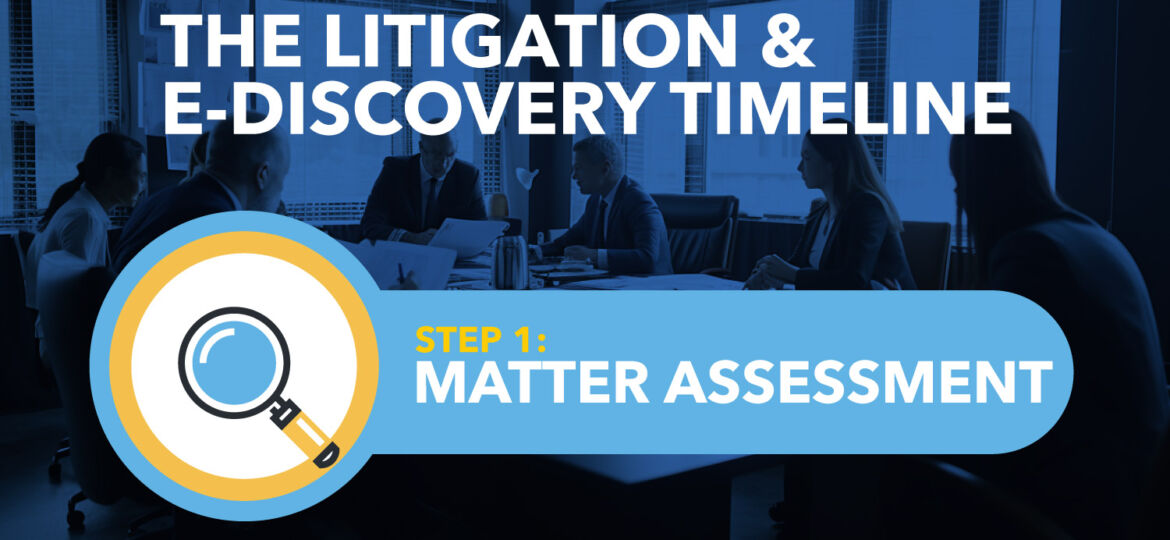

Data Narro collaborates daily with law firms of all sizes, but we work especially closely with small and medium-sized firms. These organizations often lack the capacity to maintain a dedicated team of litigation support or e-discovery specialists, which can hinder their litigation efforts and leave them without a robust set of resources for their attorneys.
Often, individual attorneys handle discovery and e-discovery processes for each of their cases independently. This ad-hoc approach can lead to varying outcomes within a law firm. We believe that firms that provide their attorneys with carefully considered discovery processes and resources can greatly improve a law firm’s overall litigation outcomes.
To help, we have developed the Litigation & E-Discovery Timeline. This easy-to-understand infographic breaks down the litigation and e-discovery timeline, offering guidance for every step along the way. This tool enables attorneys to understand their responsibilities and offers suggestions to improve each step of the process.
In the coming months, we will delve into the nine stages outlined in the timeline, ultimately compiling our advice into a downloadable ebook. This month, we will concentrate on the Initial Matter Assessment phase.
STEP 1 – INITIAL MATTER ASSESSMENT
Whenever litigation (or the threat) or litigation arises, companies must understand that they have a duty to preserve all potentially relevant and responsive information stored within their company’s communication and information systems. Attorneys are responsible for guiding companies through this process and ensuring that the company takes proactive and defensible steps to preserve ESI.
An Initial Matter Review should be conducted as soon as an attorney understands the potential implications of a lawsuit. They should promptly consult with a litigation support or e-discovery specialist, making it a standard and immediate practice.
It’s crucial that the attorney has guidance from a professional that understands information systems, ESI preservation methods, and cost-effective ways to collect ESI based on the needs of the matter. If the law firm does not have in-house e-discovery expertise, they should have an e-discovery firm on retainer and make this resource available for all litigation attorneys.
While a comprehensive review of ESI sources will occur later, it is essential to start identifying potentially relevant information, its format, and its location. This foundational knowledge enables attorneys to ask pertinent questions to guide preservation efforts and issue legal holds.
HELPFUL TEMPLATES:
- Legal Hold Templates: Many businesses have armed their in-house legal departments with legal hold software. For companies that lack this resource, you should have a set of legal hold templates that can be customized for each matter.
- Discovery Process Flowchart: A flowchart can effectively communicate the stages of the e-discovery timeline to clients and internal staff. (Use ours as a starting point for yours.)
- Discovery Process Organization Chart: While a formal diagram is not necessary, it is recommended that you start to define roles and responsibilities for the discovery matter as soon as possible.
- Discovery Process Documentation: Ideally, your law firm should have a blueprint for successful discovery efforts, including a directory of resources and approved vendors for specialized services. In a perfect world, this would include a document that could be modified and used as the basis of your own e-discovery documentation. Remember, e-discovery practices need to be defensible, and the best way to do this is to document your decisions, actions, and results.
Upon completing the Initial Matter Assessment, attorneys should possess a good understanding of potential ESI sources and have compiled a preliminary list of essential custodians and IT personnel. Moreover, they must issue legal holds and monitor compliance, guaranteeing that recipients are fully aware of and committed to their preservation responsibilities.
CONCLUSION & NEXT STEPS:
The Initial Matter Assessment is a critical first step in the litigation and e-discovery timeline. Careful planning during this phase increases the likelihood of success in subsequent stages. Keep an eye out for our upcoming article on the ESI Assessment stage. To ensure you never miss an article, subscribe to our newsletter by filling out our contact form.
The Litigation & E-Discovery Timeline (Summarized)
The threat of litigation requires immediate action to preserve potentially relevant ESI.
The attorney calls litigation support for an initial matter assessment concerning potential sources of ESI, preservation obligations, and legal hold management.
In preparation for collection, a meticulous review of ESI sources & custodians is initiated.
Interview department heads & IT staff to develop a comprehensive data map. Interview custodians to complete the ESI picture. All efforts are fully documented.
The legal team is provided with proper guidance to negotiate terms of discovery.
Be prepared with a starting ESI protocol template. Contain discovery costs by objecting to overburdensome collections. Defining acceptable search criteria & scope. Make sure production specs make sense.
Identified sources of potentially responsive ESI are collected.
E-Discovery pros will provide guidelines for ESI collection and can manage the process. Use forensic collection for computers, servers, mobile devices, and cloud/social media accounts.
Smart culling & processing of data will save enormous amounts of time in review.
E-Discovery professionals can guide you to the most efficient methods of culling raw data sets in order to avoid costly review and hosting costs.
The data set is reviewed and analyzed for responsiveness and legal privilege.
Maximize the efficiency of review by defining review protocols and maximizing the use of predictive coding/AI. Consider using outsourced managed review.
.
Productions can be tricky. Often, it is best left to certified professionals.
Turning over your responsive documents to the opposing party can be nerve-racking. Manage the process with a QA checklist to ensure privileged material remains confidential.
Expert Witness & Exhibit Prep
Prep your documents for presentation at trial. Engage a digital forensics professional for expert testimony for digital forensic matters.
Proper preservation and archiving of responsive material are crucial.
Data can be put into short-term cold storage, ready to be accessed quickly if needed. Alternatively, materials can be taken offline and placed in a long-term archive.

